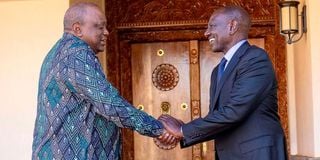Breaking News: Former Lugari MP Cyrus Jirongo dies in a road crash

President William Ruto when he paid a courtesy call to former President Uhuru Kenyatta in Gatundu on December 9, 2024.
Jamhuri Day celebrations on Thursday took place in the context of a vortex of politics with rumours of an impending shake-up of the Cabinet, among other changes. Earlier in the week, President William Ruto visited former President Uhuru Kenyatta at his Gatundu home, sending political talking heads clucking away in excitement.
Political engagement is a much more mature and crafty approach — whether it is out of desperation or not — than emotional outbursts that achieve nothing more than the personal satisfaction of hitting back over a grudge.
From the outside, the government looks to be politically in pretty bad shape. Whatever benefits may have accrued from its economic efforts are not being appreciated because of the pains of taxation, presumed erosion of social protections, fairly widespread job losses and fear that things could get worse, particularly if there is a debt default.
Worst of all, because suppliers and contractors do not seem to be consistently and predictably paid, there is a widespread sense of not having money in the country. It does not help that, rightly or wrongly, Kenyans seem to believe that the new elite are eating meat while taxpayers are having to make do with water and oats.
Vote of no confidence
From an electoral and power point of view, UDA’s coalition appears to be unstable and in a state of flux. By getting rid of Rigathi Gachagua, UDA also compromised its support in the Mt Kenya region and put a chunk of its strength in the Parliament in the toss-up column. Theoretically, this means that UDA needs the support of ODM to be sure that a vote of no confidence does not cut short its term.
However, this creates another unacceptable situation, similar to the one Mr Kenyatta was in back in 2017 — he needed Mr Ruto’s allies in Parliament to defeat an attempt to fire him in the House. Now Mr Ruto really needs Mr Odinga. Only difference is, Mr Kenyatta was a whole lot more popular with the public than Mr Ruto today.
There are two opposing forces that drive political elites in Kenya. The first one is a centripetal stampede towards government; they want in, at all costs, for the deals and the perks. The majority only pretend that their (non-existent) values would not allow them to join such and such a government, but in all honesty there is nothing Kenyan politicians hate more than being in opposition.
There are exceptions of course, but they are not very many. The other one is a centrifugality: those who are already inside will go to great lengths to repel those who are outside and fighting to get in. The biggest defence force will come from those who are in government not by the ballot but through coalition or other informal arrangements, reportedly involving large sums of money and big State jobs.
Formidable coalition
I still believe that a coalition of Mr Odinga and Mr Ruto is formidable, but it is one built on quicksand. It is a rational, pragmatic arrangement that can be dissolved by one party without consulting the other. Mr Ruto might not be all that clever but he is wily enough to know that a president does not put his tenancy in power in the hands of another politician, especially one capable of leaving you at the lights if it makes sense to do so.
And here is how I am reading his trip to Gatundu: First, he is de-risking his coalition with ODM, he is moseying towards Mr Kenyatta as a safety measure to ensure that if Mr Odinga dumps him, then he has a viable alternative play. Secondly, Mr Ruto knows the Mt Kenya constituency is big, relatively wealthy and capable of causing no end of trouble, and the last thing he wants is for Mr Gachagua to walk away with it, not of all of it anyway.
Mr Kenyatta is a magnet that could draw pieces of that constituency away from Mr Gachagua. So, secretly he might still want to isolate that region, but rather than taking it on head-on, he weakens it by dividing it and then conquering the pieces. So Deputy President Kithure Kindiki takes the East while the West is divided between UDA loyalists and the Mr Gachagua and Mr Kenyatta centres of influence.
On the other side of the argument, many Central Kenya figures know the pain of the 41 against one isolation of the past and they want to avoid it. So you have a situation ripe for a deal where both sides are ready and willing to deal. But, however you look at it, Mr Odinga is still sitting pretty, if he can hang on to his support even if he is out of the political scene.
***
Folks are ambivalent about former Prime Minister Raila Odinga’s candidacy for the chairmanship of the African Union Commission chairmanship. In my mind it is quite clear: He is by far the best candidate. He has a wealth of experience, knows Africa better than most, he is effortlessly pan-African in orientation and he has the political skills and networks to mobilise the continent to build a better future. His local political postures notwithstanding, he is a great asset for the African Union.
Mr Mathiu, a media consultant at Steward-Africa, is a former Editor-in-Chief of Nation Media Group. [email protected]










